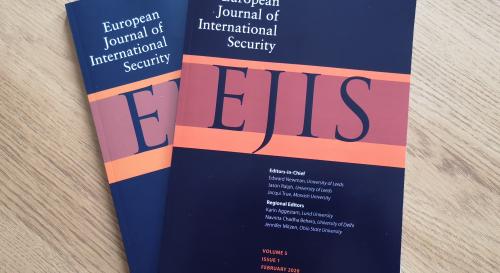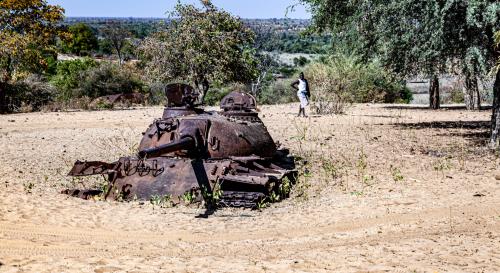
Breadcrumbs navigation
How do international organizations interact?
Understanding cooperation, competition and adaptation through the lens of organizational ecology.
In this article, Christian Downie breaks new ground by building on the theoretical insights of organizational ecology to examine IO competition, cooperation, and adaptation in the domain of energy. The full article was recently published in BISA journal Review of International Studies.
In many policy domains there is now a proliferation of international organizations. Take energy as an example. There is the Organization of the Petroleum Exporting Countries (OPEC), which was established in the 1960s, the International Energy Agency (IEA), which was established in the 1970s, the International Energy Forum (IEF) and the Energy Charter Treaty both created in the 1990s, and the more recent International Renewable Energy Agency (IRENA), which was established in 2009, among others. At the same time other international organization, such as the Organization for Economic Cooperation and Development (OECD), World Bank, and International Monetary Fund (IMF) also work in the domain of energy.
While we know a lot about individual organizations, we know much less about the dynamics of their interactions. Why do international organizations compete for funding? Why do they sometimes cooperate and work together? And can these organizations adapt as the world changes? The answers to these questions matter because interactions between international organizations have important implications for who sets global agendas and rules on some of the most pressing issues facing the globe from energy and climate change, to food security and global health?
In this paper I break new ground by building on the theoretical insights of organizational ecology to answer these questions. Typically IR scholars focus their analytical lens on individual international organizations. In other words, their unit of analysis is the organization. In this piece I shift focus to look at the population of international organizations. I draw on theories of organizational ecology that are common in sociology, to demonstrate the insights that an ecological perspective can bring to the study of international organizations, but I also show the limits of this perspective. In doing so, my aim to provide a framework for understanding how international organizations compete, cooperate and adapt. Organizational ecology is essentially focussed on competition, but as I argue, a failure to permit the possibility of other forms of interaction, such as cooperation, risks tunnel vision. Insights from other variants of ecological theory can draw attention to forms of organizational interactions in the periphery, broadening what our theoretical frameworks can see.
To explore these questions I set out three hypotheses. I will go through each in turn. If you are interested in how I study these organizations and or the theoretical scaffolding that underpins them; the link to the full academic article is below with much more detail. But for now, let me take you on a whirlwind tour of cooperation, competition and adaption.
International organization will compete for funding
If organizational ecology is right, we would assume that international organizations working in the same area will compete for material resources, such as money to pay for their programs and staff. In the domain of energy, this is largely what I found. When I asked officials in these organization about their interactions the overwhelming theme was one of competition. As one put it ‘IOs are competing all the time’, or as another stated ‘turf wars are a natural part of organisational behaviour’.
In some policy domains, including energy, one way international organizations compete is to be the focal actor. In other words, they compete to be the number 1 agency. One illustration of this is when new global issues rise in prominence. For example, following the failure of the Millennium Development Goals (MDGs) to include a goal on energy in 2000, the UN campaigned to put energy access on the international agenda, given that billions of people worldwide remained without access to electricity. It was in this context that Sustainable Energy for All was established with a key goal to ensure universal access to modern energy services by 2030. In response the IEA, one of the biggest and oldest organization working on energy also began devoting greater attention to energy access, including in its flagship publication the World Energy Outlook. As one official claimed, the ‘IEA is definitely trying to compete in the energy access space now’, and there is a ‘big turf battle’ between several international organizations working on this issue.
International organizations are more likely to cooperate when they have a shared goal
Despite the evident competition between organizations, the interesting question is why do they sometimes work together to solve global problems? Or at least try to? There are a number of answers to this question, but interviews with officials in these organisations indicated that when they have a transparent goal this can act as a very strong glue work to work together. In the article I get into the reasons why this is the case and highlight how different types of goals may be more likely to encourage cooperation than others. But the key point is that shared goals can lead international organisations to put aside their competitive tendencies work together.
In the case of energy, one example was the Sustainable Development Goals. In 2015 the United Nations adopted 17 sustainable development goals designed to achieve a more sustainable future for the globe. In the particular case I look at, one of these goals led international organizations to cooperate in order to estimate total global fossil fuel subsidies. That is, the public money governments spend subsidising the production and consumption of oil, gas, and coal. What became apparent was that shared goals that cannot be achieved individually by organisations, or ones that produce structures to facilitate their attainment, such as joint committees, can encourage organisations to cooperate.
Despite what organizational ecology typically assumes, organizations can adapt
This heading is a little unfair because scholars of organisational ecology do concede that under certain conditions organisations are able to adapt in response to changes in the external environment. Nevertheless, consideration of how individual organisations adapt remains a blind spot in the literature. To assess to what extent international organisations could adapt in the domain of energy, I zeroed in on the IEA. I did so not only because it is one of the most prominent energy organization, but because it is a most likely case. Organization ecologists concede that large established organisations that are politically well-connected will be the ones most likely to adapt. As I explain in the paper, the IEA certainly meets this criteria.
In fact, the agency which was established in 1974 originally to deal with oil security has changed dramatically over the last few decades. The clearest illustration has been the agency’s attempt to broaden its membership beyond a rich club of OECD countries. For example, by working more closely with countries like China, India and Brazil. It is not the only one. The OECD has done the same to varying degrees. For instance, in 2007 it instituted an ‘enhanced engagement program’ directed toward Brazil, China, India, Indonesia and South Africa, with ‘a view to possible membership’, following ongoing questions about its legitimacy in the international community given that it didn’t include these countries as members.
What’s next?
Regardless of the global policy domain that is of interest, what I hope the article highlights is the need for scholars, and for that matter policymakers, to pay more attention to how international organizations interact.
Not only because it is important if these organization are to help address pressing global problems, but also because there is much more work to be done to understand when and how international organizations cooperate, compete and adapt, and the consequences of doing so. I conclude the article by suggesting what might be some of the most promising avenues for future research.
Want to know more? You can read the full Review of International Studies article at DOI: https://doi.org/10.1017/S0260210521000267
BISA members receive access to RIS (and to our other journal European Journal of International Security) as a benefit of membership. To gain access, log in to your BISA account and scroll down to the 'Membership benefits' section. If you're not yet a member join today.
Photo by israel palacio on Unsplash


